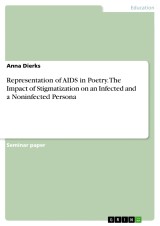Details

Representation of AIDS in Poetry. The Impact of Stigmatization on an Infected and a Noninfected Persona
1. Auflage
|
CHF 15.00 |
|
| Verlag: | Grin Verlag |
| Format: | |
| Veröffentl.: | 24.09.2018 |
| ISBN/EAN: | 9783668803862 |
| Sprache: | englisch |
| Anzahl Seiten: | 19 |
Dieses eBook erhalten Sie ohne Kopierschutz.
Beschreibungen
Seminar paper from the year 2018 in the subject Didactics - English - Literature, Works, grade: 2,3, University of Paderborn (Anglistik / Amerikanistik), course: The Body in American Poetry, language: English, abstract: Earvin “Magic” Johnson shocked the world when he announced his HIV infection and immediately retired from the L.A. Lakers in 1991 (Stevenson). Up to this point, HIV/AIDS was popularly believed to be a disease that only occurred among homosexual men which was heavily stigmatized. The former basketball star had to face discrimination from his own team mates when they did not want to play with him anymore and rejected him from their team (Moughty). Even though Johnson took a break from basketball and was hurt by his team mates reactions, he became one of the most important spokesmen for HIV/AIDS education (Moughty). His case helped the public understand that the virus does not only occur among gay communities and should be of everyone’s concern (Moughty).
The AIDS epidemic began in the U.S. in the early 80’s when the first few reported cases of gay men were made public. The number of infections increased rapidly and the majority of the people living with AIDS were gay. Because of this, stereotypes and stigma for the sick people developed quickly which had a very negative impact on their quality of life and their health status. Isolation, depression and self-harm were among consequences to the society’s rejection of these gay men as well as other people with HIV/AIDS. Stigma and stigmatization has many levels. It does not only involve discrimination from people who are not affected, but also refers to self-perception of the infected person, metaphors of the illness and intersection with other prejudices. Apart from the strong stigmatization of the illness, the medical condition itself is already a great burden for the infected persons.
Although today, symptoms can be medicated effectively so that an unrestricted life is possible, this was not the case in the early years of the epidemic when medical experts could not even determine the way of transmission. This interrelates with the great fear that society developed and the resulting social distance to sufferers. This issue was picked up by filmmakers, art and literature. In this term paper, I investigate upon the question how HIV/AIDS related stigma is represented in poetry in the time from the beginning of the epidemic up to the early 1990’s in the United States. [...]
The AIDS epidemic began in the U.S. in the early 80’s when the first few reported cases of gay men were made public. The number of infections increased rapidly and the majority of the people living with AIDS were gay. Because of this, stereotypes and stigma for the sick people developed quickly which had a very negative impact on their quality of life and their health status. Isolation, depression and self-harm were among consequences to the society’s rejection of these gay men as well as other people with HIV/AIDS. Stigma and stigmatization has many levels. It does not only involve discrimination from people who are not affected, but also refers to self-perception of the infected person, metaphors of the illness and intersection with other prejudices. Apart from the strong stigmatization of the illness, the medical condition itself is already a great burden for the infected persons.
Although today, symptoms can be medicated effectively so that an unrestricted life is possible, this was not the case in the early years of the epidemic when medical experts could not even determine the way of transmission. This interrelates with the great fear that society developed and the resulting social distance to sufferers. This issue was picked up by filmmakers, art and literature. In this term paper, I investigate upon the question how HIV/AIDS related stigma is represented in poetry in the time from the beginning of the epidemic up to the early 1990’s in the United States. [...]


















